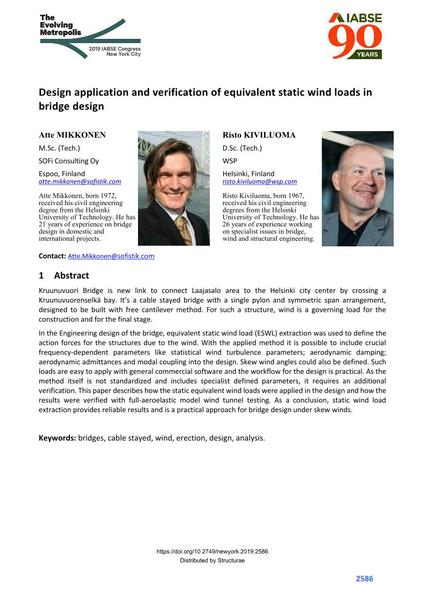Design application and verification of equivalent static wind loads in bridge design

|
|
|||||||||||
Bibliographic Details
| Author(s): |
Atte Mikkonen
(SOFi Consulting Oy)
Risto Kiviluoma (WSP) |
||||
|---|---|---|---|---|---|
| Medium: | conference paper | ||||
| Language(s): | English | ||||
| Conference: | IABSE Congress: The Evolving Metropolis, New York, NY, USA, 4-6 September 2019 | ||||
| Published in: | The Evolving Metropolis | ||||
|
|||||
| Page(s): | 2586-2592 | ||||
| Total no. of pages: | 7 | ||||
| DOI: | 10.2749/newyork.2019.2586 | ||||
| Abstract: |
Kruunuvuori Bridge is new link to connect Laajasalo area to the Helsinki city center by crossing a Kruunuvuorenselkä bay. It’s a cable stayed bridge with a single pylon and symmetric span arrangement, designed to be built with free cantilever method. For such a structure, wind is a governing load for the construction and for the final stage. In the Engineering design of the bridge, equivalent static wind load (ESWL) extraction was used to define the action forces for the structures due to the wind. With the applied method it is possible to include crucial frequency-dependent parameters like statistical wind turbulence parameters; aerodynamic damping; aerodynamic admittances and modal coupling into the design. Skew wind angles could also be defined. Such loads are easy to apply with general commercial software and the workflow for the design is practical. As the method itself is not standardized and includes specialist defined parameters, it requires an additional verification. This paper describes how the static equivalent wind loads were applied in the design and how the results were verified with full-aeroelastic model wind tunnel testing. As a conclusion, static wind load extraction provides reliable results and is a practical approach for bridge design under skew winds. |
||||
| Keywords: |
design wind bridges erection analysis cable-stayed
|
||||
